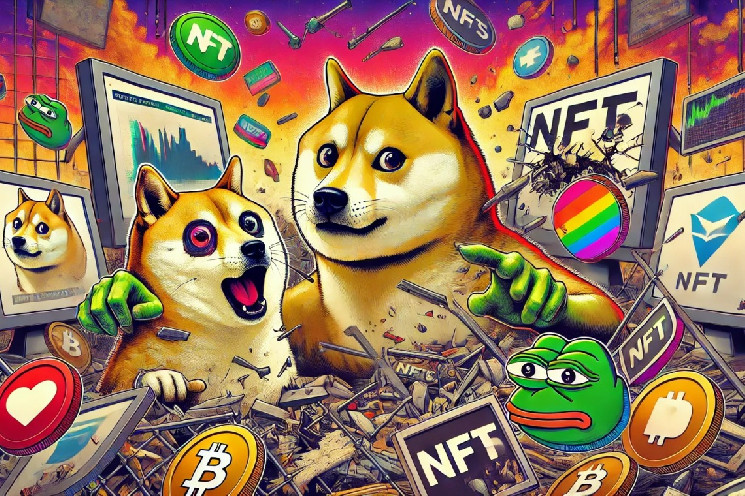It appears that there is an inverse correlation between the memecoin market and that of NFTs, with the prices of these two types of assets moving in opposite directions.
The memecoin market in particular could be the cause of the strong suffering of the NFT market at the moment.
The drop in NFT prices: is this the memecoin market’s fault?
If we compare the trend of the past few months in the memecoin market with that of NFTs, there actually seems to be an inverse correlation.
Using CryptoSlam’s monthly NFT sales volume chart, it is noted that a real collapse has occurred as of June 2022.
Since then, the lowest point was recorded in September 2023, with only $300 million in monthly transactions.
Notably, after a brief and controlled peak in December 2023, NFT daily trading volumes remained above 25 million in 2024 until April, before plummeting to just over 10 million between May and June.
In fact, monthly trading volume for the recently ended June was only $462 million, which is far less than December 2023’s $1.7 billion.
In other words, monthly volumes went from $1.7 billion in December 2023 to $462 million in June 2024 over the year, with a near-constant decline of 74%, mostly concentrated in the last two months.
The memecoin market is pushing NFT prices down
Many memecoins have performed well in 2024.
For example, if we take the gains or losses from December 31, 2023 as a reference, Dogecoin is at +40%, Shiba Inu at +66%, Pepe even at +725% and Floki at +363%.
Even the new WIF (dogwifhat) registers a sensational +1,300%, while Bonk stops at +77%.
These figures as a whole seem to indicate a possible capital flight from the NFT market to that of memecoins.
However, if only the last 30 days are considered, the inverse correlation does not appear to be present.
The market prices of all six major memecoins lost between 21% and 35% in June, with the overall movements decidedly similar to each other.
Monthly trading volumes on the NFT market fell by 25% in June compared to May, which is a decline of the same order of magnitude as memecoin prices.
Prices and volumes
However, you should not compare prices with volumes, because they are two different things.
However, it is possible that a drop in NFT sales volumes will correspond to a drop in prices, as volumes are calculated by multiplying prices by quantities.
So if on the one hand there seems to be no direct correlation, the circulating hypothesis is that in the second quarter of the current year, overall, a wave of new memecoins about VIP, politics and animals may have diverted attention. capital from the NFT market, and the crypto market downturn did the rest.
It is worth noting that the total volumes of the NFT market in June were even lower than the lowest monthly peak of 2022, the year of the bear market, and this suggests that there could be some kind of slowdown between this market and that of the NFT -market. the meme coins.
On the other hand, for example, the historic peak of monthly trading volume of NFTs was recorded in January 2022, more than two months after that of the crypto market.
The hypothesis of the co-founder of Animoca Brands
In a recent interview, Animoca Brands co-founder and executive chairman Yat Siu stated that he believes the NFT market could recover.
He argued that a new speculative bubble should not be necessary for this market to recover, because NFTs can also be used in games, for intellectual property rights and for many other things, and this could generate demand.
However, it is clear from his words that the boom in the NFT market has already happened, and the conditions do not seem to be in place for another real and real boom in the short term.
On the other hand, he thinks it is illogical that the monthly trading volumes are so low and he mainly attributes this to the summer period. In fact, he believes that when market activity resumes, there will be increased volumes, transactions and activity.
This hypothesis could also explain why even the major memecoins performed poorly in June.
The recovery of the market
Many expect a recovery of the memecoin market, after the general decline in June.
It is not certain that the usual memecoins will always perform well, as new ones are constantly being created that sometimes manage to make a splash and attract capital that does not flow to other memecoins.
It is also possible that during periods when memecoins – especially new ones – attract a lot of capital, this is also pulled out of the NFT market, and it is possible that summer is not a particularly brilliant period for the financial markets as a whole.
For example, even in June 2021 there was a decline in monthly volumes of NFTs, but July saw the first major boom. June 2022 was a bloodbath, but it featured the implosion of the Terra/Luna ecosystem. In 2023, the decline lasted a full eight months, from March to October.
All this makes it possible to imagine that sooner or later this market will recover, even if, as Yat Siu says, we may have to wait for a wider and more massive use of NFT technology, even beyond the art market.













